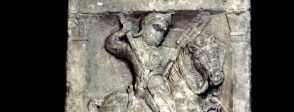The auxiliary units were the most ethnically diverse sections of the Roman army, but even by the end of the 1st century AD, the spread of Roman citizenship meant that the legions themselves were no longer exclusively Italian. There is evidence for the presence in Britain of Roman troops from many different parts the empire. Most of them were from elsewhere in Europe, but some were from further afield, for example, North Africa and the Middle East.
Roman soldier from Macedonia

The tombstone from Lincoln of Gaius Saufeius, a Roman soldier from Macedonia.
See more See more: https://www.google.com/culturalinstitute/beta/asset/tombstone-of-gaius-saufeius/bAH7YfTC87J1AQRoman soldier from Hungary

The tombstone from Lincoln of Titus Valerius Pudens, a Roman soldier from present-day Hungary.
See more See more: https://www.google.com/culturalinstitute/beta/asset/tombstone-of-titus-valerius-pudens/nwEM_hC8mu8-IgRoman altar from Cumbria

An altar from Maryport, Cumbria, dedicated by an army officer from Algeria.
See more See more: https://www.google.com/culturalinstitute/beta/asset/altar/hAHU_jCxkrsDewRoman cavalryman

Bronze figurine of a Roman cavalryman from North Africa.
See more See more: https://www.google.com/culturalinstitute/beta/asset/bronze-figurine-of-a-moorish-cavalryman/WQFcaYtkp9z4SQDischarge certificate

A discharge certificate from Cheshire for Reburrus, a Spanish cavalry officer.
See more See more: http://www.britishmuseum.org/research/collection_online/collection_object_details.aspx?objectId=818074&partId=1&searchText=Discharge+certificate&page=1

